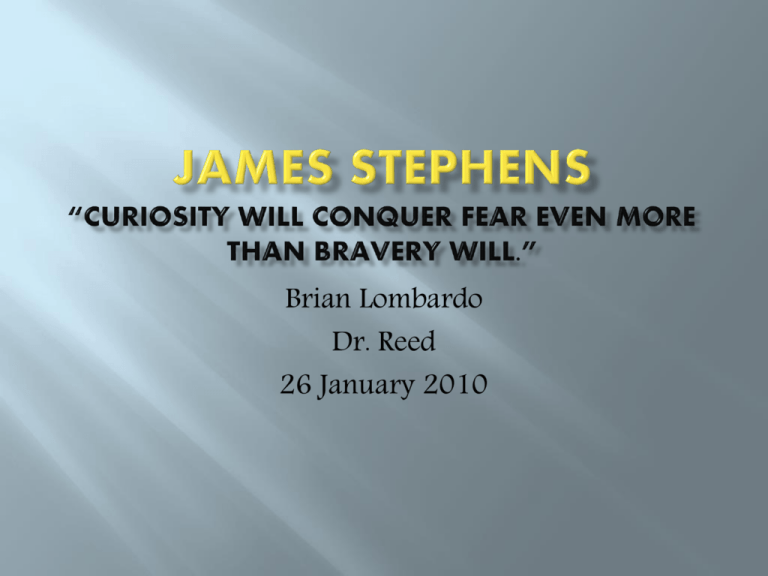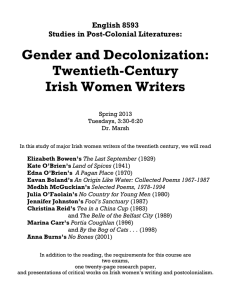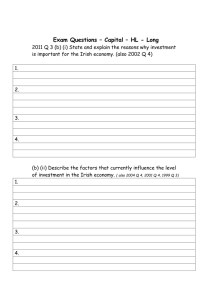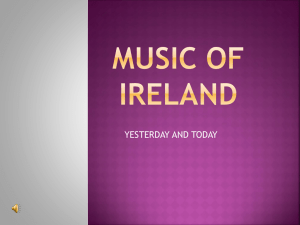James Stephens
advertisement

Brian Lombardo Dr. Reed 26 January 2010 Born February 2, 1882 in Dublin Father passed away when he was 2 years old When James was 6, his mother remarried and abandoned him Attended Meath Protestant Industrial School for Boys brutal, ruthless treatment at Meath ran away and became homeless, living with various charitable families and on the streets of Dublin 1896 - Began working as a typist in a solicitor’s office 1905 – First story, “The Greatest Miracle”, published in the newspaper The United Irishman by Arthur Griffith, an Irish Nationalist 1907 – began contributing to Sinn Fein, Griffith’s magazine dedicated to the Irish Nationalist cause “We Ourselves” Emerged in early 1900’s Organizations of Nationalist Groups, working for Irish Home Rule 1916 – Contemporary critics called the Easter Rising the “Sinn Fein Rebellion” 1917 – After the party was reorganized, it upset the Assembly of Ireland party in the 1918 general election 1907 – at his job at the solicitor’s office, he was introduced to poet George Russell Russell introduced him to other notable Irish persons, including Yeats, Lady Gregory, and George Moore Took classes on the Gaelic League and became politically active Published various pieces dealing with Irish Nationalism, encouraging readers to remember Irish ancient tales and traditions Published in 1912, his most notable work Written as a children’s story, but held various philosophical undertones and criticisms The work ingeniously condemns organized occupations (doctors, businessmen, etc.) and the religious class for narrowing the abilities of the human mind Also comments humorously on Irish gender relations Won the Polignac Prize for fiction in 1912 Because of the tremendous success enjoyed by Crock of Gold, Stephens retired as a typist Moved to Paris to work full-time as a writer 1919 – Married Cynthia Kavanagh, his lover of 12 years Moved back to Dublin in 1915 and held the position of Registrar of the National Gallery of Ireland until 1924 During the Rebellion in Easter 1916, Stephens saw a man being shot This event impacted his later literary products. Directly recounted in his 1916 The Insurrection in Dublin. Evidence can be seen of his stronger Irish pride and attention to Irish literature from an earlier time Philosophical Combination of fantasy and realism Humorous Display Irish National Pride and desire for Irish home-rule Accurate depictions of traditional Irish culture and traditions Presence of varied characters, with whom many readers could relate Mixture of Short Stories, Poems, and Novels Poetry Collections: Insurrections (1909) Reincarnations (1918) The Kings and the Moon (1938) Short stories: “Hunger” (1918) “Etched in Moonlight” (1928) Novels: The Charwoman’s Daughter (1912) My enemy came nigh, And I Stared fiercely in his face. My lips went writhing back in a grimace, And stern I watched him with a narrow eye. Then, as I turned away, my enemy, That bitter heart and savage, said to me: "Some day, when this is past, When all the arrows that we have are cast, We may ask one another why we hate, And fail to find a story to relate. It may seem then to us a mystery That we should hate each other." Thus said he, And did not turn away, Waiting to hear what I might have to say, But I fled quickly, fearing had I stayed I might have kissed him as I would 1925 - Moved to London 1928 - Became a broadcaster for the BBC 1935 – Developed a friendship with James Joyce 1937 – began giving lectures on the BBC on poetry Decline in physical health and mental capacity 1950 – died in London, England on December 26 Academic Search Complete. Stephens, James. Funk & Wagnalls New World Encyclopedia http://www.answers.com/topic/james-stephens Martin, Augustine. James Stephens: A Critical Study. 1977. http://www.poemhunter.com/jamesstephens/ http://www.poemhunter.com/poem/hate-3/ http://www.sinnfein.org/documents/intro.html








